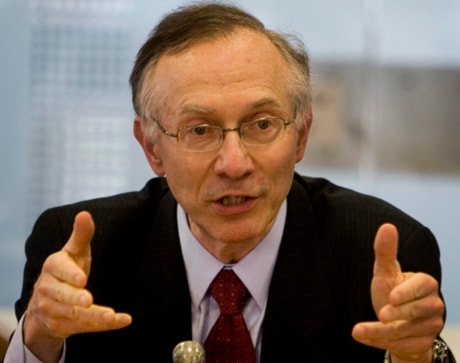TORONTO — Judging the world’s response to the H1N1 pandemic requires a special perspective — looking at the past through eyes that aren’t clouded by the present, suggests the man leading an international review of the global pandemic response.
Dr. Harvey Fineberg, who is chairing the World Health Organization’s pandemic review committee, says critiquing decisions made last spring, summer and fall based on what is now known about the H1N1 virus won’t uncover the lessons the world needs to learn.
“This is one of the really, I would say, sine qua non of a fair assessment,” says Fineberg, using the Latin phrase that means an essential ingredient.
“You have to look at each decision from the vantage point of what was understood and known at that time. You still may be very critical, or you may be laudatory or you may be somewhere in between. But it’s certainly inappropriate to look at it from a vantage point after the fact.”
Still, Fineberg, who is president of the U.S. Institute of Medicine, says assessing the response based on what was known at the time won’t give decision makers a free pass.
“Even prospectively you can still attend to errors of calculation and insufficient utilization of available information, failure to outline all of the options, failure to think about alternatives, failure to communicate successfully,” he said in an interview with The Canadian Press.
“That’s part of what I hope we’ll look into. And part of what I hope we can maintain as a committee, is this sense of looking retrospectively but with a prospective attitude.”
Wednesday marked the first anniversary of the initial revelation that a storm might be brewing on the influenza front.
On April 21, 2009, the U.S. Centers for Disease Control issued a special report revealing that two children in California had been infected with a brand new swine influenza virus. The children had no known exposure to pigs and no ties to each other, suggesting they were the tip of an as-yet-unseen iceberg.
“I think this is one of those situations where everyone will want to stay tuned,” the head of the CDC’s influenza division, Dr. Nancy Cox, warned presciently at the time.
Within days the cases were linked to an alarming outbreak of severe flu-like illness in previously healthy young adults in Mexico. Though it would take seven weeks for the WHO to declare it, the pandemic of 2009 had begun.
Despite the early warning signs from Mexico, the pandemic turned out to be milder than first feared. While it will take several years for good global estimates to be calculated, the U.S. says over 12,000 Americans have died from H1N1 infections so far.
Public health officials say 428 Canadians were killed by the virus. And the WHO, which is also still reporting only directly attributed deaths, says nearly 18,000 people have died worldwide.
A swelling chorus of critics contends that the pandemic response — which in countries like Canada included mass vaccination efforts — was an overblown reaction to an overhyped threat. Some critics have alleged that the academic researchers who advised the WHO were too closely tied to the pharmaceutical industry, which stood to gain richly from a pandemic declaration.
Fineberg has said the review committee would like to hear from informed critics, though he says details of who the group will consult and how they will do it remain to be worked out.
Fineberg may be uniquely qualified to lead a review of the global response to the H1N1 pandemic. That’s because he — along with Richard Neustadt, the late Harvard professor and adviser to several U.S. presidents — conducted an inquiry into the response to an earlier influenza outbreak, the 1976 swine flu scare.
In the fall of 1976, more than 40 million Americans were vaccinated to protect against a virus that had actually already sputtered out, though that wasn’t clear at the time. A still unexplained side-effect of that vaccine led to more deaths — about 25 — than did the swine flu virus itself and the vaccination program was cancelled.
Their report The Swine Flu Affair: Decision-Making on a Slippery Disease criticized the U.S. response for not unlinking the decision to make pandemic vaccine and the decision to use it.
That lesson — don’t commit to taking a measure before a commitment is needed — was often cited by public health leaders last year as they struggled to figure out how to respond to H1N1.
But where some might be tempted to draw parallels between critiquing the swine flu pandemic and the swine flu scare, Fineberg sees the jobs as vastly different.
“This is not even a distant cousin,” he says of the task before him.
“I mean, it’s influenza, but that’s a little bit like saying breakdancing and ballroom are both dancing. This is totally different,” Fineberg says, pointing to the scale of the reviews and the size and composition of the review teams.
The current review committee is made up of 29 people from a variety of countries and disciplines.
“The one parallel that may be worth noting is that in both instances, the purpose is to learn lessons to inform better choices next time.... That was true in ’76 and it’s also true of this experience.”
The committee, which met for the first time last week, is to report to WHO Director General Dr. Margaret Chan in time for her to present the findings to the World Health Assembly — the WHO’s annual meeting — in May 2011.
But the mandate is broad and already Fineberg is admitting the entire job may not be completed within that timeframe.
“I think there’s a recognition the committee may find it has to carry on some parts of its work for a different length of time,” he says.
“We’re trying to do the job right. We’re not trying only to meet a deadline.”
